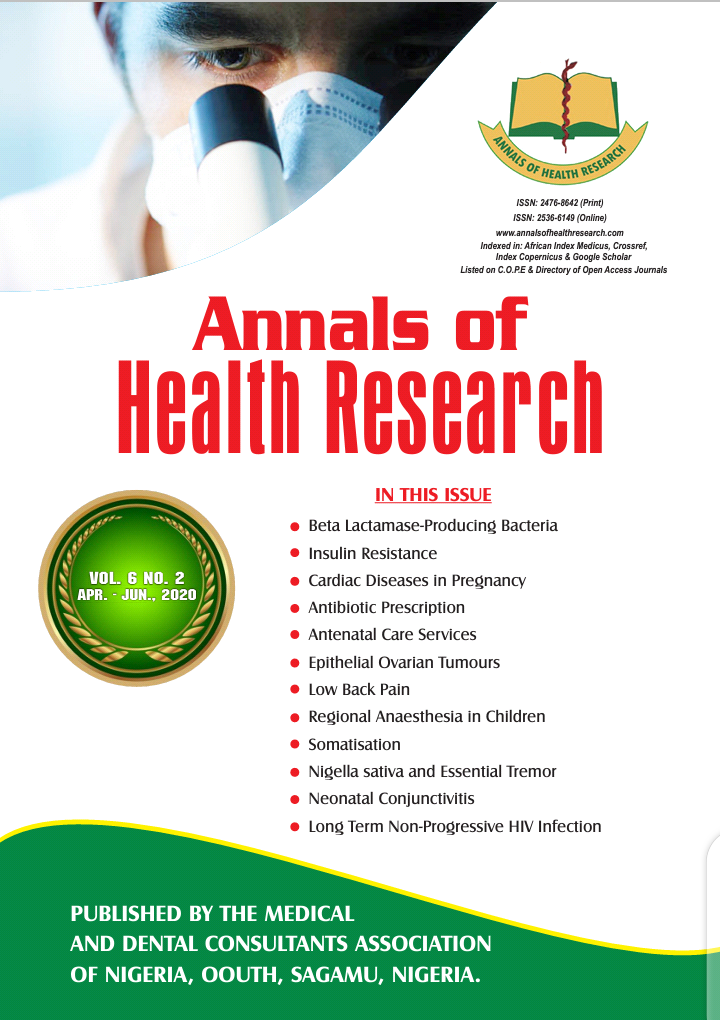Low back pain among hospital workers in Kano, North-west Nigeria
DOI:
https://doi.org/10.30442/ahr.0602-08-81Keywords:
Hospital Workers, Low Back Pain, Nigeria, Prevalence, Risk factorsAbstract
Background: About 90% of individuals will experience back pain at one point or the other in their lives. Hospital workers are considered to have a considerable risk of developing low back pain.
Objective: To determine the prevalence and risk factors for low back pain among health workers in tertiary hospitals in Kano, Nigeria.
Methods: The study was a cross-sectional survey. A questionnaire was designed and administered to 200 personnel of the teaching hospitals in Kano. Socio-demographic characteristics, presence of low back pain, factors that relieve and aggravate the low back pain and relationship of back pain and work activities, were recorded on the questionnaire.
Results: The mean age of the respondents was 33.4±7.08 years. Sixty-six per cent of the respondents had back pain within a year of the study. There was a 29% point prevalence of low back pain among the respondents. Statistically significant association was established between various activities such as prolonged sitting and walking and pain in the lower back (p = 0.000). There was an association between low back pain and the type of job (department) of the respondents (p = 0.016). The dull ache was the predominant presentation (58%) followed by piercing and gripping in 20% and 19% respectively. Prolonged sitting was the main aggravating factor, while numbness was the main feature of referral in 18%. Only 5.0% of the respondents used medications for their back pain.
Conclusion: Low back pain is common among hospital workers with a point prevalence of 29.1%. About 25% had low back pains that prevented participated in normal duty. Majority of the respondents believed back pain is preventable.
References
Brennan G, Shafat A, Mac Donncha C, Vekins C. Lower back pain in physically demanding college academic programs: a questionnaire-based study. BMC Musculoskelet Disord 2007; 8: 67.
Bos E, Krol B, van der Star L, Groothoff J. Risk factors and musculoskeletal complaints in non-specialized nurses, IC nurses, operation room nurses, and X-ray technologists. Int Arch Occup Environ Health 2007; 80: 198–206.
Omokhodion FO, Umar US, Ogunnowo BE. Prevalence of low back pain among staff in a rural hospital in Nigeria. Occupational Med 2000; 50: 107–110.
Bello B, Adebayo HB. A Systematic Review of the Prevalence of Low Back Pain in Nigeria. Middle East J Rehab Health [Internet] 2017; 4. Available from: http://jrehabilhealth.com/en/articles/13146.html
Yang H, Haldeman S, Lu M-L, Baker D. Low Back Pain Prevalence and Related Workplace Psychosocial Risk Factors: A Study Using Data From the 2010 National Health Interview Survey. J Manipulative Physiol Ther 2016; 39: 459–472.
Saravi BM, Kabirzadeh A, Rezazadeh E, Khariki MF, Asgari Z, Farahabadi EB, et al. Prevalence and Causes of Medical Absenteeism Among Staff (Case Study at Mazandaran University of Medical Sciences: 2009-2010). Mater Sociomed 2013; 25: 233–237.
Sikiru L, Hanifa S. Prevalence and risk factors of low back pain among nurses in a typical Nigerian hospital. Afr Health Sci 2010; 10: 26–30.
Lagerström M, Hansson T, Hagberg M. Work-related low-back problems in nursing. Scand J Work Environ Health 1998; 24: 449–464.
Wami SD, Abere G, Dessie A, Getachew D. Work-related risk factors and the prevalence of low back pain among low wage workers: results from a cross-sectional study. BMC Public Health 2019; 19: 1072.
O’Sullivan P, Caneiro JP, O’Keeffe M, O’Sullivan K. Unraveling the Complexity of Low Back Pain. J Orthop Sports Phys Ther 2016; 46: 932–937.
Awosan KJ, Yikawe SS, Oche OM, Oboirien M. Prevalence, perception and correlates of low back pain among healthcare workers in tertiary health institutions in Sokoto, Nigeria. Ghana Med J 2017; 51: 164–174.
Walker BF. The prevalence of low back pain: a systematic review of the literature from 1966 to 1998. J Spinal Disord 2000; 13: 205–217.
Usman MI, Abubakar MK, Muhammad S, Rabiu A, Garba I. Low Back Pain in Pregnant Women Attending Antenatal Clinic: The Aminu Kano Teaching Hospital Experience. Ann Afr Med 2017; 16: 136–140.
Hoy D, Brooks P, Blyth F, Buchbinder R. The Epidemiology of low back pain. Best Pract Res Clin Rheumatol 2010; 24: 769–781.
d’Errico A, Viotti S, Baratti A, Mottura B, Barocelli AP, Tagna M, et al. Low back pain and associated presenteeism among hospital nursing staff. J Occup Health 2013; 55: 276–283.
Punnett L, Prüss-Utün A, Nelson DI, Fingerhut MA, Leigh J, Tak S, et al. Estimating the global burden of low back pain attributable to combined occupational exposures. Am J Ind Med 2005; 48: 459–69.
Karahan A, Kav S, Abbasoglu A, Dogan N. Low back pain: prevalence and associated risk factors among hospital staff. J Adv Nurs 2009; 65: 516–524.
Sanya AO, Omokhodion FO, Ogwumike OO. Risk factors for Low Back Pain among hospital workers in Ibadan, Oyo State, Nigeria. J Niger Soc Physiother 2009; 15: 31–34.
Keriri H. Prevalence and risk factors of low back pain among nurses in operating rooms, Taif, Saudi Arabia. American J Res Communication 2013; 1: 45–70.
AlDajah S. Prevalence and risk factors of Low Back Pain among nurses in Sudayr Region. Eur Sci J 2013; 9: 198–205.
Cilliers L, Maart S. Attitudes, knowledge and treatment of low back pain amongst nurses in the Eastern Cape, South Africa. Afr J Prim Health Care Fam Med 2013; 5.
Lahad A, Malter AD, Berg AO, Deyo RA. The effectiveness of four interventions for the prevention of low back pain. JAMA 1994; 272: 1286–1291.
Andersson GB. Epidemiology of low back pain. Acta Orthop Scand Suppl 1998; 281: 28–31.
Downloads
Published
Issue
Section
License
The articles and other materials published in the Annals of Health Research are protected by the Nigerian Copyright laws. The journal owns the copyright over every article, scientific and intellectual materials published in it. However, the journal grants all authors, users and researchers access to the materials published in the journal with the permission to copy, use and distribute the materials contained therein only for academic, scientific and non-commercial purposes.


